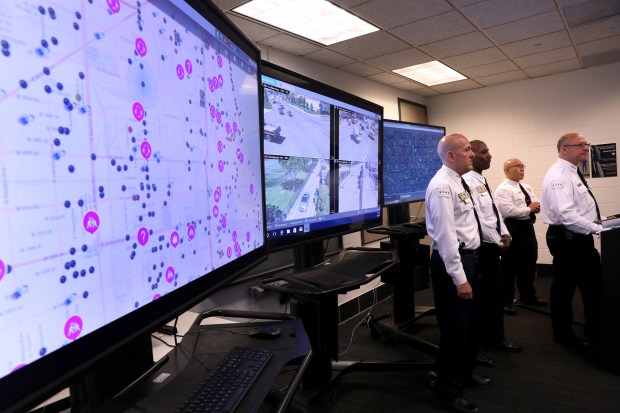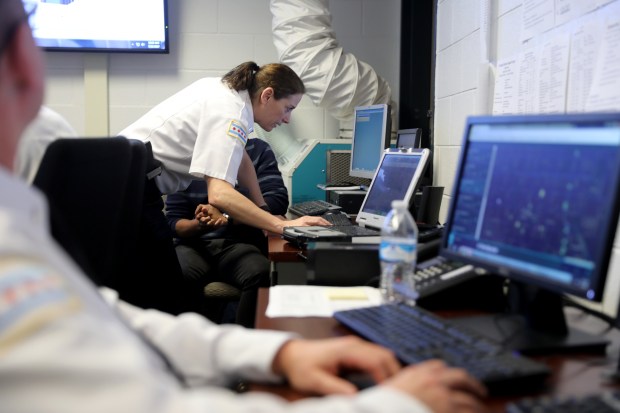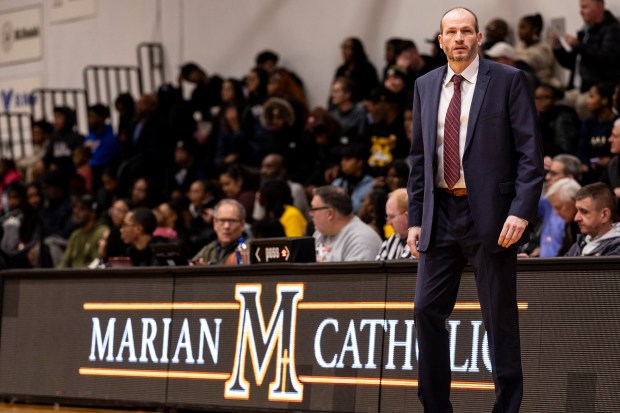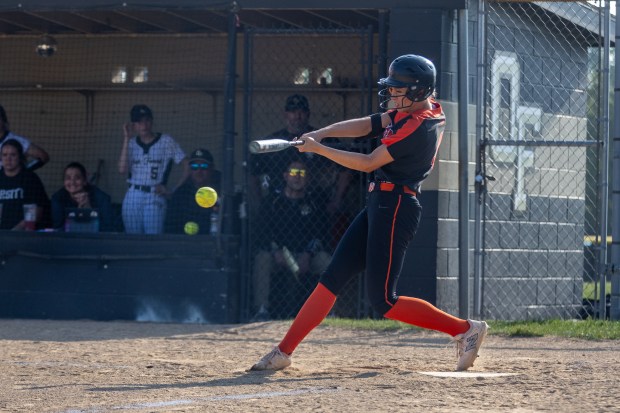Early one morning last May, on a bungalow-lined street in Avalon Park, ShotSpotter detected real gunshots: more than half a dozen rounds fired.
It was a busy night, and officers didn’t make it to the scene for more than half an hour. But when they arrived they found 24-year-old Aréanah Preston, a Loyola law student and Chicago police officer, fatally shot on her front lawn.
Late one night in January, on a residential block of Auburn Gresham, ShotSpotter detected what likely were just fireworks.
But the alert sent officers out looking for a shooter, and when they got there they heard a loud bang. One officer opened fire in the direction of a boy who had just set off a firecracker, but did not hit him.
The episodes paint a picture of the limits of a controversial system Chicago has decided to keep around well past this summer’s Democratic National Convention after a protracted contract fight. Police see value in the system’s ability to bring them to trouble including at times when no one calls 911, but its usefulness may quickly downgrade from there, experts said.
In recent weeks, long-standing criticisms have intensified, among them that the system is inaccurate, expensive and disproportionately harms people of color. Some attorneys argue ShotSpotter shouldn’t be used in the courtroom or on the street, claims that judges could be sorting out for months if not years to come.
Mayor Brandon Johnson was an outspoken critic of the system on the campaign trail, but what some perceive as a lack of clarity from him has only clouded the city’s future relationship with the gunshot-detection technology.
Johnson announced last month that the city would stop using ShotSpotter later this year, a clarification that came after significant confusion and speculation that the company could take the technology offline much sooner. As it stands, the end date is now Sept. 22 — after Democrats hold their convention here — to be followed by a two-month transition period.
But the software has been consistently praised by police, including Johnson’s hand-picked top cop, Larry Snelling, who credit it for quicker responses to shootings. ShotSpotter can and, according to officers, often does alert police to gunfire that citizens do not call in. The Chicago Police Department has said that, in the last three years, CPD officers responding to a ShotSpotter alert rendered lifesaving medical aid 430 times.
Examining the system
One recent study found that, compared to 911 calls alone, ShotSpotter alerts will bring police to a crime scene faster and keep them there longer. But the software has no effect on overall public safety — it does not reduce gun violence or improve CPD’s clearance rate.
“I think it’s important for cities that invest in this technology to think a little bit harder about what are the ends and what are the means,” said Eric Piza, a criminal justice and criminology professor at Northeastern University and principal investigator of the study, which was published in January with a grant from the Justice Department.
The study, believed to be “the largest research project on gunshot detection technology (GDT) to date,” examined ShotSpotter alert response data by police officers in Kansas City, Missouri, from 2012 through 2019 and in Chicago from 2017 through 2019.
In that time, ShotSpotter sensors in Chicago made more than 85,000 alerts of possible gunfire on the city’s South and West sides, the study found.
“I think an honest assessment of what we found is that the software tends to do what the vendor promises, in terms of identifying gunshots, in terms of directing police attention to gunshots,” Piza said. “We also found in Chicago that more guns were recovered on ShotSpotter incidents than other types of incidents.”
What’s more, Piza and the other investigators found, CPD officers dispatched via ShotSpotter alerts arrived at shooting scenes about 10 seconds faster than officers who responded to shootings with only 911 calls.
But none of that necessarily led to safer streets, Piza said. “Gun violence did not change in ShotSpotter areas following installation of the software, shootings were not any more likely to be solved by police after the software was introduced.”
A recent CPD analysis found that the vast majority of ShotSpotter alerts in the Englewood and Gresham districts — 80% — did not have an accompanying 911 call from a citizen.

Not all ShotSpotter alerts are the result of bona fide gunfire, though, and some critics argue that sending police out to chase possibly inaccurate ShotSpotter alerts cuts down on the time they can spend responding to real calls for service.
“All of those officers are not available to respond to other emergencies,” said Jonathan Manes, an attorney with the MacArthur Justice Center who is suing the city in an effort to end its use of ShotSpotter. “This is not a tool that makes police more efficient, it imposes additional burdens on police for, so far as we can tell, no public safety benefit.”
A working paper from Ph.D. candidates at the University of California at Santa Barbara found that the flood of ShotSpotter alerts in Chicago resulted in longer police response times — and thus, a decrease in arrests stemming from 911 calls. The drop in arrests for domestic battery was particularly sharp: 14%.
Police tout a different statistic: Since early 2021, CPD officers responding to a ShotSpotter alert have rendered lifesaving medical aid on 430 occasions. More than 25% of those incidents were recorded in the Harrison (11th) and Englewood (7th) districts, according to CPD.
Current controversies
The city has paid between $8.8 million and $12.3 million annually for ShotSpotter since 2017, and the software and sensors now cover 136 square miles on the city’s South and West sides, according to Piza’s study.
The software, utilized in more than 140 cities across the country, uses acoustic sensors affixed to buildings and light poles to pick up the sound of gunfire. The location, within about 85 feet, and number of suspected rounds are sent to dispatchers, who relay the information to CPD officers.
ShotSpotter’s pilot program debuted in Chicago in 2012 in the CPD’s Harrison and Englewood districts, historically the two most violent in the city. In the years since, the program has expanded to cover all of the city’s West Side and most of the South Side.
Except for a few billboards along the Kennedy Expressway, ShotSpotter is not used anywhere on the North Side. It also does not operate in the Morgan Park (22nd) District on the Far South Side, which includes the Beverly and Mount Greenwood neighborhoods, where scores of city workers live and gunfire is relatively rare.
The technology’s use almost exclusively on the South and West sides has led to criticism that it encourages police to unfairly target people of color.
“There’s no doubt that it is placing people who are already the most vulnerable people in our county at risk when police show up under the false or real impression that a gunshot has been fired, without any other information,” said Sharlyn Grace, senior policy adviser at the Cook County public defender’s office.
A blistering and oft-cited 2021 report issued by the city’s Office of Inspector General found that the software also had an impact on officers’ interactions with civilians in city neighborhoods most affected by gun violence.
“OIG concluded from its analysis that CPD responses to ShotSpotter alerts rarely produce documented evidence of a gun-related crime, investigatory stop, or recovery of a firearm,” the report stated. “Additionally, OIG identified evidence that the introduction of ShotSpotter technology in Chicago has changed the way some CPD members perceive and interact with individuals present in areas where ShotSpotter alerts are frequent.”
For its part, CPD has praised the software since its rollout.
“Obviously, I’m for technology that’s going to help us get to a location quicker and help us save lives,” CPD Superintendent Snelling said at a news conference last week. “When it comes to the contractual part of it, that aspect of ShotSpotter, that lies with the Mayor’s Office. I don’t deal with that aspect of it. What I’m concerned about right now is public safety, and I’m going to do everything I can to keep the city safe.”

After a ShotSpotter alert comes in, CPD employees in district Strategic Decision Support Centers are often able to use POD cameras to help officers better coordinate shooting responses, according to sources not authorized to speak publicly about the department’s use of ShotSpotter. The software includes artificial intelligence components that, over time, allow the sensors to more accurately discern between gunshots and fireworks. Meanwhile, if a ShotSpotter alert is later deemed to be caused by fireworks, CPD officers are able to edit that incident description.
“You put them where there are the most shootings, that’s statistics,” a veteran CPD officer, familiar with the software though not authorized by the department to speak publicly, said of ShotSpotter criticisms. “Does it make sense to put them in Beverly? I don’t know, how many shootings happen in Beverly? Does it make sense to put them in Andersonville? How many shootings happen in Andersonville?”
“You put the microphones where the shootings happen,” he added.
Defense lawyers raise questions
In November 2021, police got a ShotSpotter alert that one round was fired at an address just west of the Garfield Park Lagoon.
Responding officers saw a gray Dodge Charger making a U-turn and driving off through the park, according to a police report. When they pulled it over, they found no guns, but the driver’s eyes were bloodshot and he smelled of alcohol, they said. He was arrested and charged with aggravated DUI.
A couple of years later, public defenders opened another front in the courtroom battle over ShotSpotter.
That technology is unreliable, and that arrest was unconstitutional, they said. Police can’t arrest someone without probable cause or a specific and reasonable suspicion that they committed a crime. Just being in the vicinity of a ShotSpotter alert, they argued, was not nearly enough.
In January, Judge Carol Howard agreed and threw out the arrest. And on Tuesday, prosecutors dropped the charges altogether.
Cook County public defenders have long challenged ShotSpotter in county courtrooms, saying evidence stemming from the technology should not be used against defendants.
Among their most common arguments: ShotSpotter insists it is accurate and reliable, but that has never been proved in an Illinois court; and besides, the alerts do not give police enough basis to make a valid arrest.
“The efficacy (and) the reliability is overblown,” said Assistant Public Defender Celeste Addyman, who worked on the DUI case that was recently dropped.
“It is just being used in a really inappropriate way to sort of cast doubt, or draw into suspicion, very large groups of people who would otherwise have been thought to just sort of be innocently going about their day.”
In response, Cook County prosecutors have argued in court that ShotSpotter alerts — like 911 calls — are absolutely valid to consider when looking at the overall context of whether an arrest was constitutional.
And while a courtroom inquiry into ShotSpotter’s scientific claims would be relevant if attorneys wanted to introduce “a detailed forensic analysis by ShotSpotter” at trial, that is not necessary in the context of a pretrial hearing about an arrest, prosecutors have said.
“No one, ShotSpotter included, would claim ShotSpotter is a flawless tool without any limitations,” prosecutors wrote in a 2021 filing for an armed habitual criminal case. “Such perfection is not expected under a fourth amendment analysis.”
The circumstances of the arrest in that case involved more than just ShotSpotter, according to the court filing. An officer responding to an alert near the Ashland/63rd Green Line station encountered a witness who said someone shot a gun and ran into an alley; officers found the defendant in the alley and, when patting him down, found a box of ammunition. That defendant ultimately pleaded guilty to a weapons charge.
Public defenders have asked judges to conduct evidentiary hearings at which ShotSpotter would have to prove that their technology is generally accepted as scientifically sound. So far, no judge has granted that hearing.
ShotSpotter should have to prove that it is reliable enough to use in court, said Assistant Public Defender Richard Gutierrez.
“A company who wants to engage in the criminal legal system and wants to make money in the criminal legal system should be doing so only with highly validated, highly reliable technology,” he said. “And there is no such validation, and lots of reasons to think they could never get it, that the system doesn’t work.”
When asked if prosecutors believe ShotSpotter is reliable and scientifically sound — and thus should be admissible in court — a spokesperson for the Cook County state’s attorney’s office said prosecutors “review cases individually and make determinations regarding the use and relevancy of the evidence specific to that case within the bounds of the law.
“ShotSpotter is the best resource to answer questions about the reliability of their technology, not the CCSAO,” the statement continued.
Efforts to challenge the technology in court have met with mixed success: Some judges have upheld arrests in which ShotSpotter played a role. Others have thrown them out.
No Illinois appellate court has settled the matter, and it could be months if not years before a higher court takes up the question. By then, ShotSpotter could be long gone from Chicago streets.
Attorneys with the MacArthur Justice Center have filed suit in hopes that a federal judge will stop Chicago from using ShotSpotter altogether.
The technology is unreliable and disproportionately harms communities of color, attorney Manes told the Tribune. Manes said he is appreciative of Johnson’s recent announcement that the ShotSpotter contract would end, but the lawsuit is still relevant “unless the city is willing to commit to actually terminating the program in court.”
“The city can’t end a lawsuit just by sort of making a temporary change in policy which it could just as easily switch back,” he said.
Attorneys for the city stated in court as recently as Feb. 21 that they believe ShotSpotter technology is reliable. While Manes and his colleagues wanted city attorneys to answer questions about Johnson’s statements on the issue — including campaign statements about ShotSpotter’s lack of reliability — U.S. Magistrate Judge Young B. Kim shut that down.
“These are questions that should be asked to the mayor,” the judge said.
scharles@chicagotribune.com
mcrepeau@chicagotribune.com





